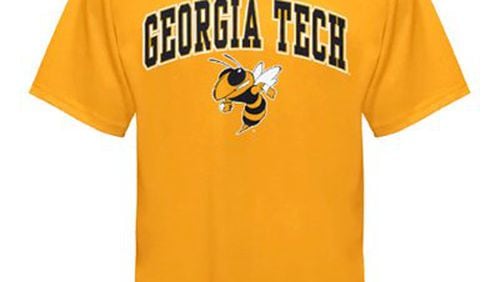How strong is the Georgia Tech brand, as judged by sales of t-shirts, magnets and other college insignia-festooned merchandise?
It looks like No. 50, according to the Collegiate Licensing Company, an Atlanta-based company that licenses merchandise for colleges, bowl games and conferences, among other things. Earlier this month, the CLC released its annual rankings of top-selling schools based on royalties reported by colleges that the company represents. The rankings covered Aug. 2013-July 2014.
The unsurprising top 10:
1. Texas
2. Alabama
3. Michigan
4. Georgia
5. Notre Dame
6. Florida
7. LSU
8. Florida State
9. Texas A&M
10. North Carolina
The schools in Tech’s neighborhood:
46. Cincinnati
47. Connecticut
48. BYU
49. Colorado
50. Georgia Tech
51. Pittsburgh
52. East Carolina
53. Rutgers
54. Montana
55. Boston College
I'm not terribly surprised, and I don't think of this as any sort of indictment, just an interesting metric. Tech doesn’t have a large alumni base compared with most of the schools ahead of it on the list and the performance of the football and basketball teams in recent years has neither driven fans to scoop up jerseys nor caused any great swelling of the fan base.
Interestingly, the rankings seem fairly static. Last year, Tech was 51st. Eight of the 10 schools within five spots of Tech this year were also within the same range last year – TCU (46), Cincinnati (48), BYU (49), Colorado (50), Pittsburgh (52), East Carolina (54), Montana (55).
The two schools that moved up were Virginia and Connecticut, which won the ACC and the national championship, respectively, which undoubtedly drove sales. Montana’s ranking is interesting, to say the least. No FCS school has a higher ranking, and it’s ahead of Northwestern, Vanderbilt and Central Florida. Grizzlies pride runs deep, evidently. (One note: Not every NCAA school is licensed by the CLC. Ohio State, Miami and N.C. State are among schools that do their licensing elsewhere.)
On-field performance is unquestionably a factor. In the 2009-10 rankings, which included Tech’s ACC championship season, the school was 41st. Since then, Tech has been 46th (11-12), 46th (12-13) and then 50th. Florida State jumped from 21st to 8th with its BCS championship season. Auburn, the BCS runner-up, moved from 18th to 11th.
In the same way, one could surmise Tech's recent slip from 46 to 51 and 50 represents an understandable lag in enthusiasm. I’m guessing Music City Bowl t-shirts were not a hot Christmas gift this year.
Alumni base clearly plays a role. Illinois, for instance, is No. 32 despite two bowl trips in the past six years (although the Illini basketball team has reached the NCAA tournament three times in the past six seasons).
Illinois has 425,000 living alumni. As of June 2013, Tech had 126,652. For what it’s worth, BYU had 402,871 as of fall 2013. Duke actually also has more than Tech (153,984 in 2013). Duke was No. 30, up four after winning the Coastal Division.
It is hard not to notice that the top 10 looks a little bit like the actual poll rankings, as well as those for attendance and recruiting. Teasing out the causality of one upon the other is a bit tricky, but it would seem to be a cycle of Team A wins, Team A's popularity grows, young fans become prospects and choose Team A, Team A wins. Paul Johnson, who takes a dim view of recruiting rankings, might add two additional segments of the cycle: Team A's fans buy recruiting service subscriptions, Team A's recruits get ranked higher.
The obvious takeaways: a) Tech needs to win more; b) alumni need to start buying more t-shirts and living longer.
About the Author







